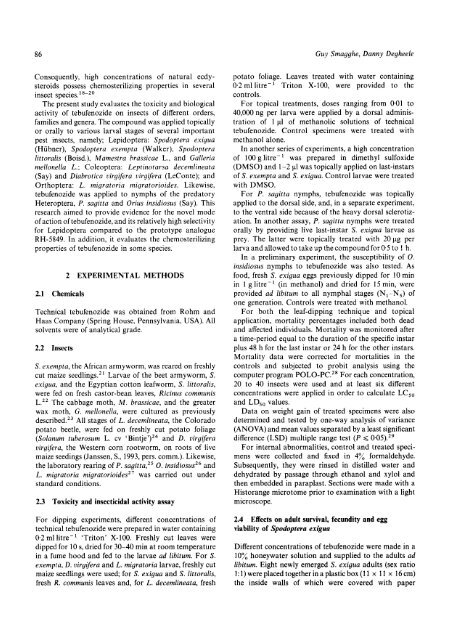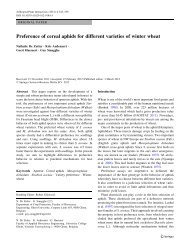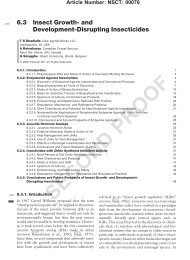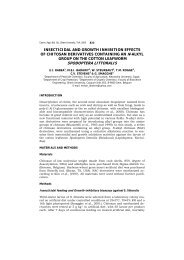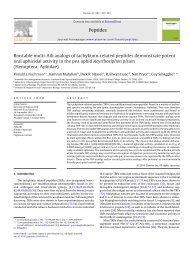Action of a novel nonsteroidal ecdysteroid mimic ... - Insects.ugent.be
Action of a novel nonsteroidal ecdysteroid mimic ... - Insects.ugent.be
Action of a novel nonsteroidal ecdysteroid mimic ... - Insects.ugent.be
You also want an ePaper? Increase the reach of your titles
YUMPU automatically turns print PDFs into web optimized ePapers that Google loves.
86 Guy Smagghe, Danny Degheele<br />
Consequently, high concentrations <strong>of</strong> natural <strong>ecdysteroid</strong>s<br />
possess chemosterilizing properties in several<br />
insect species.’8-20<br />
The present study evaluates the toxicity and biological<br />
activity <strong>of</strong> tebufenozide on insects <strong>of</strong> different orders,<br />
families and genera. The compound was applied topically<br />
or orally to various larval stages <strong>of</strong> several important<br />
pest insects, namely; Lepidoptera: Spodoptera exigua<br />
(Hiibner), Spodoptera exempta (Walker), Spodoptera<br />
littoralis (Boisd.), Mamestra hrassicae L., and Galleria<br />
mellonella L.: Coleoptera: Leptinotarsa decemlineata<br />
(Say) and Diabrotica uirgijera uirgifera (LeConte); and<br />
Orthoptera: L. migratoria migratorioides. Likewise,<br />
tebufenozide was applied to nymphs <strong>of</strong> the predatory<br />
Heteroptera, P. sagitta and Orius insidiosus (Say). This<br />
research aimed to provide evidence for the <strong>novel</strong> mode<br />
<strong>of</strong> action <strong>of</strong> tebufenozide, and its relatively high selectivity<br />
for Lepidoptera compared to the prototype analogue<br />
RH-5849. In addition, it evaluates the chemosterilizing<br />
properties <strong>of</strong> tebufenozide in some species.<br />
2.1 Chemicals<br />
2 EXPERIMENTAL METHODS<br />
Technical tebufenozide was obtained from Rohm and<br />
Haas Company (Spring House, Pennsylvania, USA). All<br />
solvents were <strong>of</strong> analytical grade.<br />
2.2 <strong>Insects</strong><br />
S. exempta, the African armyworm, was reared on freshly<br />
cut maize seedlings.’, Larvae <strong>of</strong> the <strong>be</strong>et armyworm, S.<br />
exigua, and the Egyptian cotton leafworm, S. littoralis,<br />
were fed on fresh castor-<strong>be</strong>an leaves, Ricinus communis<br />
L.” The cabbage moth, M. brassicae, and the greater<br />
wax moth, G. mellonella, were cultured as previously<br />
de~cri<strong>be</strong>d.’~ All stages <strong>of</strong> L. decemlineata, the Colorado<br />
potato <strong>be</strong>etle, were fed on freshly cut potato foliage<br />
(Solanum tu<strong>be</strong>rosum L. cv ‘Bit~tJe’)~~ and D. uirgifera<br />
uirgijera, the Western corn rootworm, on roots <strong>of</strong> live<br />
maize seedings (Janssen, S., 1993, pers. comm.). Likewise,<br />
the laboratory rearing <strong>of</strong> P. sagitta,2s 0. insidiosus26 and<br />
L. migratoria rnigratorioide~~~ was carried out under<br />
standard conditions.<br />
2.3 Toxicity and insecticidal activity assay<br />
For dipping experiments, different concentrations <strong>of</strong><br />
technical tebufenozide were prepared in water containing<br />
02 ml litre-’ ‘Triton’ X-100. Freshly cut leaves were<br />
dipped for 10 s, dried for 30-40 min at room temperature<br />
in a fume hood and fed to the larvae ad libitum. For S.<br />
exempta, D. uirgifera and L. migratoria larvae, freshly cut<br />
maize seedlings were used; for S. exigua and S. littoralis,<br />
fresh R. communis leaves and, for L. decemlineata, fresh<br />
potato foliage. Leaves treated with water containing<br />
0.2 ml litre-’ Triton X-100, were provided to the<br />
controls.<br />
For topical treatments, doses ranging from 001 to<br />
40,000 ng per larva were applied by a dorsal administration<br />
<strong>of</strong> 1 pl <strong>of</strong> methanolic solutions <strong>of</strong> technical<br />
tebufenozide. Control specimens were treated with<br />
methanol alone.<br />
In another series <strong>of</strong> experiments, a high concentration<br />
<strong>of</strong> 100 g litre-’ was prepared in dimethyl sulfoxide<br />
(DMSO) and 1-2 p1 was topically applied on last-instars<br />
<strong>of</strong> S. exempta and S. exigua. Control larvae were treated<br />
with DMSO.<br />
For P. sagitta nymphs, tebufenozide was topically<br />
applied to the dorsal side, and, in a separate experiment,<br />
to the ventral side <strong>be</strong>cause <strong>of</strong> the heavy dorsal sclerotization.<br />
In another assay, P. sagitta nymphs were treated<br />
orally by providing live last-instar S. exigua larvae as<br />
prey. The latter were topically treated with 20 pg per<br />
larva and allowed to take up the compound for 0.5 to 1 h.<br />
In a preliminary experiment, the susceptibility <strong>of</strong> 0.<br />
insidiosus nymphs to tebufenozide was also tested. As<br />
food, fresh S. exigua eggs previously dipped for 10 min<br />
in 1 g litre-’ (in methanol) and dried for 15 min, were<br />
provided ad libitum to all nymphal stages (N,-N,) <strong>of</strong><br />
one generation. Controls were treated with methanol.<br />
For both the leaf-dipping technique and topical<br />
application, mortality percentages included both dead<br />
and affected individuals. Mortality was monitored after<br />
a time-period equal to the duration <strong>of</strong> the specific instar<br />
plus 48 h for the last instar or 24 h for the other instars.<br />
Mortality data were corrected for mortalities in the<br />
controls and subjected to probit analysis using the<br />
computer program POLO-PC.28 For each concentration,<br />
20 to 40 insects were used and at least six different<br />
concentrations were applied in order to calculate LC,,<br />
and LD,, values.<br />
Data on weight gain <strong>of</strong> treated specimens were also<br />
determined and tested by one-way analysis <strong>of</strong> variance<br />
(ANOVA) and mean values separated by a least significant<br />
difference (LSD) multiple range test (P < 0.05).29<br />
For internal abnormalities, control and treated specimens<br />
were collected and fixed in 4% formaldehyde.<br />
Subsequently, they were rinsed in distilled water and<br />
dehydrated by passage through ethanol and xylol and<br />
then em<strong>be</strong>dded in paraplast. Sections were made with a<br />
Historange microtome prior to examination with a light<br />
microscope.<br />
2.4 Effects on adult survival, fecundity and egg<br />
viability <strong>of</strong> Spodoprera exigua<br />
Different concentrations <strong>of</strong> tebufenozide were made in a<br />
10% honeywater solution and supplied to the adults ad<br />
libitum. Eight newly emerged S. exigua adults (sex ratio<br />
1: 1) were placed together in a plastic box (1 1 x 1 1 x 16 cm)<br />
the inside walls <strong>of</strong> which were covered with paper


